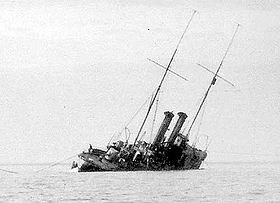Claes Uggla (ship)
|
|
|
|---|---|
 The accrued Claes Uggla |
|
| Overview | |
| Type | Torpedo cruiser |
| Shipyard | |
| Keel laying | 1898 |
| Launch | December 9, 1899 |
| Namesake | the Admiral Claas Uggla |
| Commissioning | November 28, 1900 |
| Technical specifications | |
| displacement |
814 t, maximum 846 t |
| length |
72.9 m over everything |
| width |
8.3 m |
| Draft |
3.02 m |
| crew |
104 men |
| drive |
8 yarrow boilers , |
| speed |
20.5 kn |
| Range |
1200 nm at 12 kn |
| Armament |
2 × 12 cm L / 45 M94 Bofors cannon, |
| Coal supply |
130 t |
The Claes Uggla , which entered service in 1900, was the fifth torpedo cruiser (Swedish Torpedkryssare) in the Swedish fleet and the Örnen class. More precisely, the boats would have been called torpedo cannon boats, the British versions of which they were modeled on. The Claes Uggla was the only boat in the class that was lost in service. On June 22, 1917, she ran up while securing a Swedish coastal convoy in the archipelago near the island of Ulvön near Örnsköldsvik . Attempts to divert the ship further destroyed the hull and on August 30, 1917 the Claes Uggla capsized .
Building history
The Claes Uggla and the preceding Psilander were on the Finnboda yard of Bergsunds Group built in Stockholm. Their armament did not differ from the previous boats. They too had two 12 cm L / 45 Bofors -M.94 rapid-fire guns with protective shields on the fore and aft deck and four 5.7 cm L / 55 Maxim Nordenfeldt rapid-fire guns in swallow nests on the sides . In addition there was the underwater torpedo tube in the bow. The armor of the two boats also consisted of a 19 mm thick armored deck made of normal steel.
However, the last two boats in the class had a slightly modified, longer hull with a modified bridge and slightly different masts. The two triple expansion engines supplied by Motala Verkstad were somewhat more powerful with a total of 4500 hp, the necessary steam was still generated by eight small water-tube boilers of the Yarrow type , which had actually been designed for torpedo boats .
Mission history
The Claes Uggla entered service on November 28, 1900 as the fifth “cruiser” of the Swedish Navy and the last boat in the Örnen class. The boat was named after the Swedish admiral Claas Uggla (1614–1676), who was the second in command in the sea battle at Öland against the Danes and Dutch under Cornelis Tromp , Niels Juel and Philipp van Almonde .
1901 was the Claes Uggla . next to the coastal armored ships Thor , Oden and Niord , the first boat of the Swedish Navy to be fitted with a radio system. After the unilateral declaration of the abandonment of the Swedish-Norwegian Union by the Norwegian Storting in June 1905, the Swedish fleet was put on alert. The increase in tension led to the relocation of part of the fleet to the west in order to attack the Norwegian coast and the capital, then still called Kristiania , in the event of an escalation of the conflict . The Claes Uggla belonged to this association with three sister ships. After Norwegian independence was recognized in the Karlstad negotiations , the fleet was withdrawn on October 11, 1905.
During the First World War she then monitored the Swedish waters and served as an escort vehicle. On June 22, 1917, she ran up while securing a Swedish coastal convoy in the Gulf of Bothnia in the archipelago near the island of Ulvön near Örnsköldsvik . Attempts to divert the ship further destroyed the hull and on August 30, 1917 the Claes Uggla capsized .
The Örnen- class torpedo cruisers
| Surname | Shipyard | Launch | In service from | Final fate |
|---|---|---|---|---|
| Örnen | Lindholmens , Gothenburg | August 6, 1896 | May 4, 1897 | June 16, 1947 a. D., sunk in 1950 as a target ship |
| Claes Horn | Lindbergs , Stockholm | February 9, 1898 | August 1898 | December 1923 a. D. |
| Jacob Bagge | Kockums , Malmo | April 30, 1898 | November 1898 | June 1947 a. D., scrapped in 1951 |
| Psilander | Bergsunds , Finnboda Varv | November 25, 1899 | July 1900 | July 1937 a. D., sunk as a target ship on August 3, 1939 |
| Claes Uggla | Bergsunds, Stockholm | December 9, 1899 | November 1900 | Accumulated June 22, 1917, sunk on August 30, 1917 |
literature
- B. Weyer: Taschenbuch der Kriegsflotten. JF Lehmanns Verlag, Munich, 1905
- Per Insulander, Curt Borgenstam, Bertil Åhlund: Kryssare: med Svenska flottans kryssare under 75 år. CB Marine Literature, ISBN 9789197070065
Web links
- The Örnen class
- Postcard of Claes Uggla
- Photo of the " Clas Uggla , Kanonbåt"
- [1] (PDF; 520 kB) and [2] Swedish reports on the loss of Claes Uggla , pictures from the rescue attempt
- Picture of the wreck of the Claes Uggla 2007
Remarks
- ↑ Weyer 1905, p. 95
